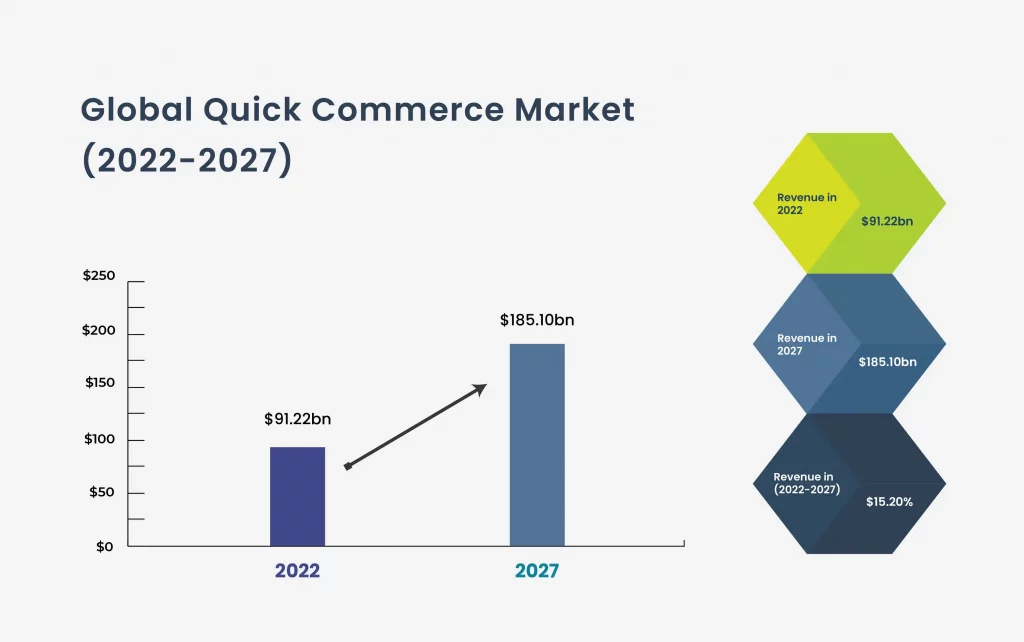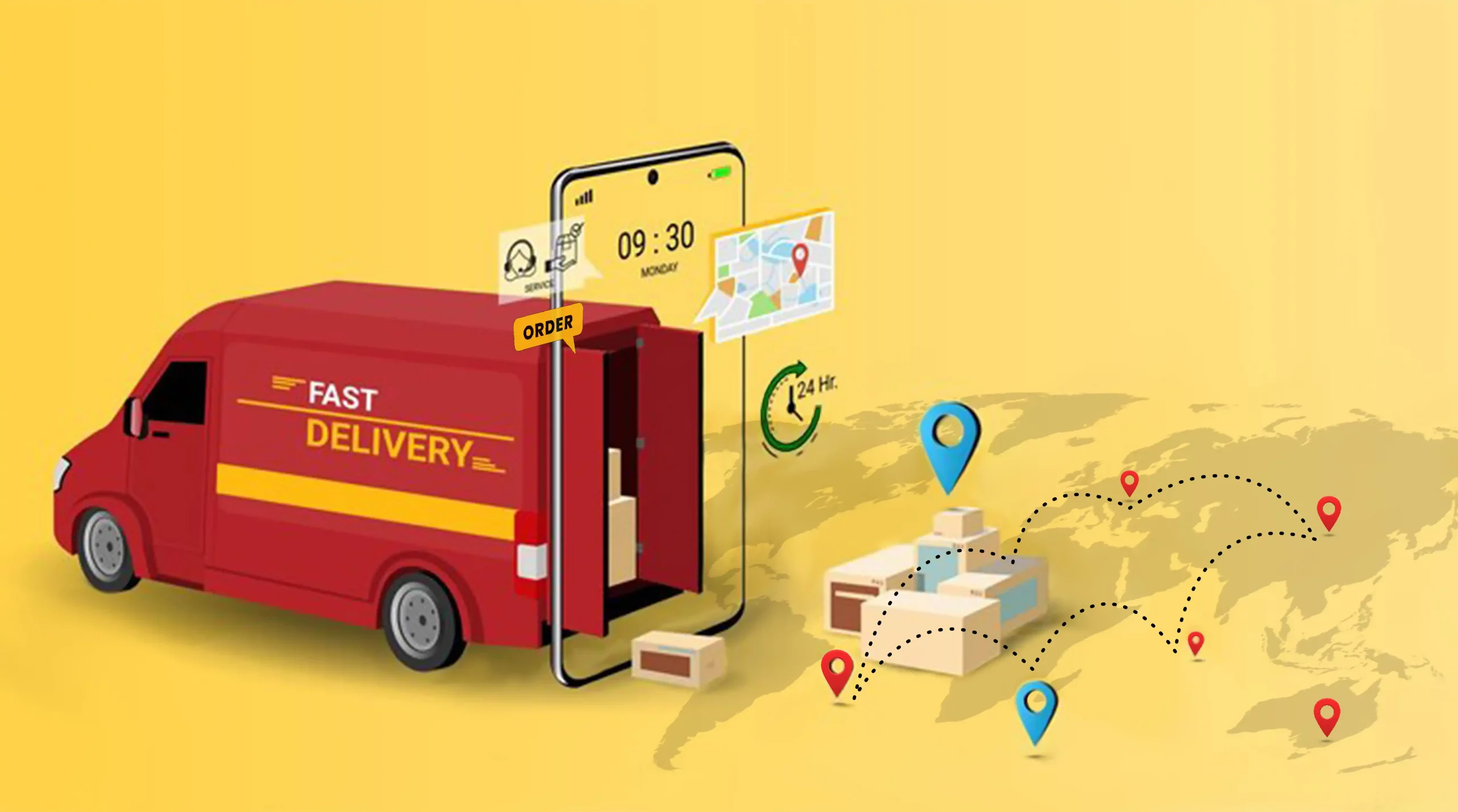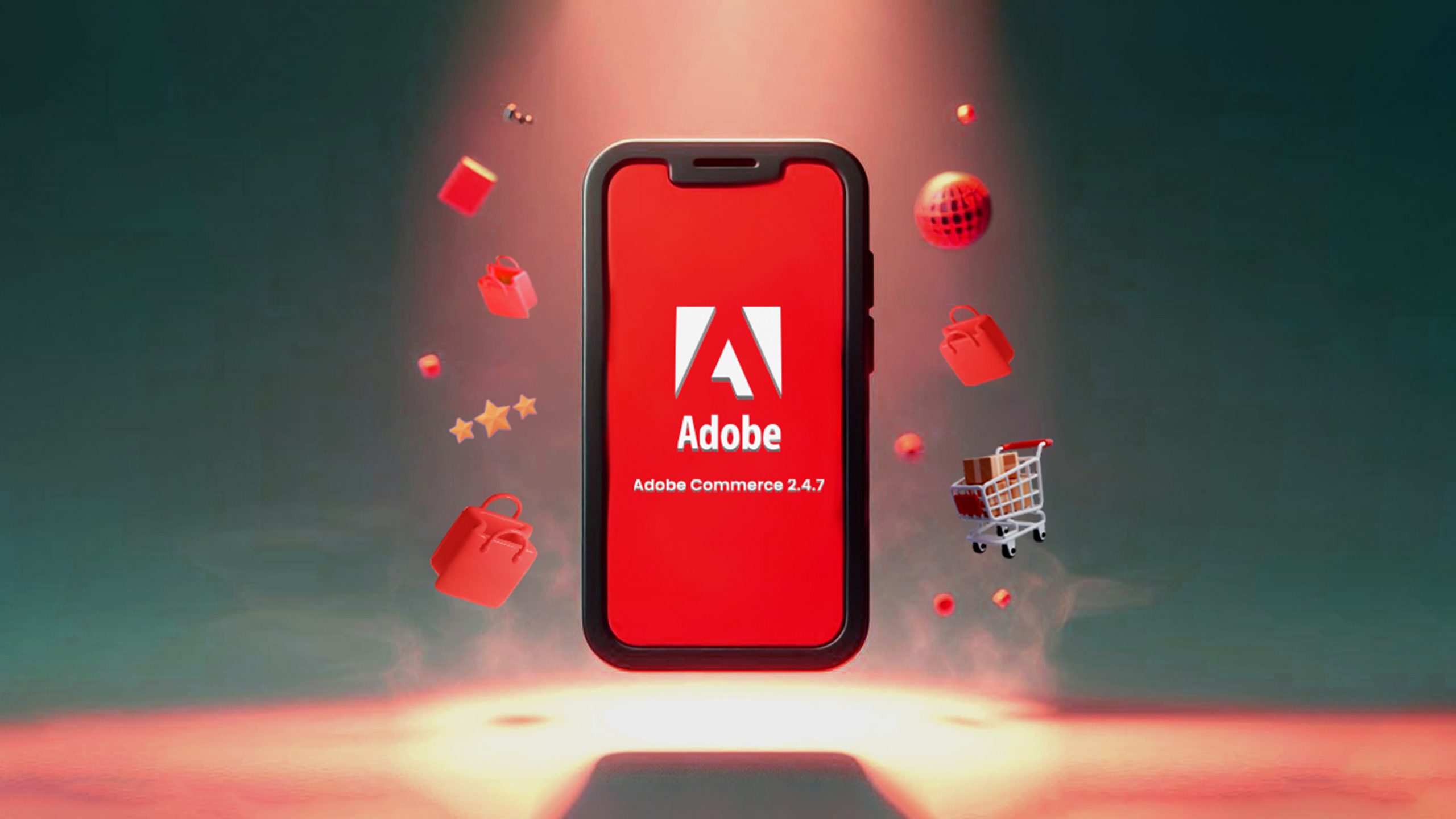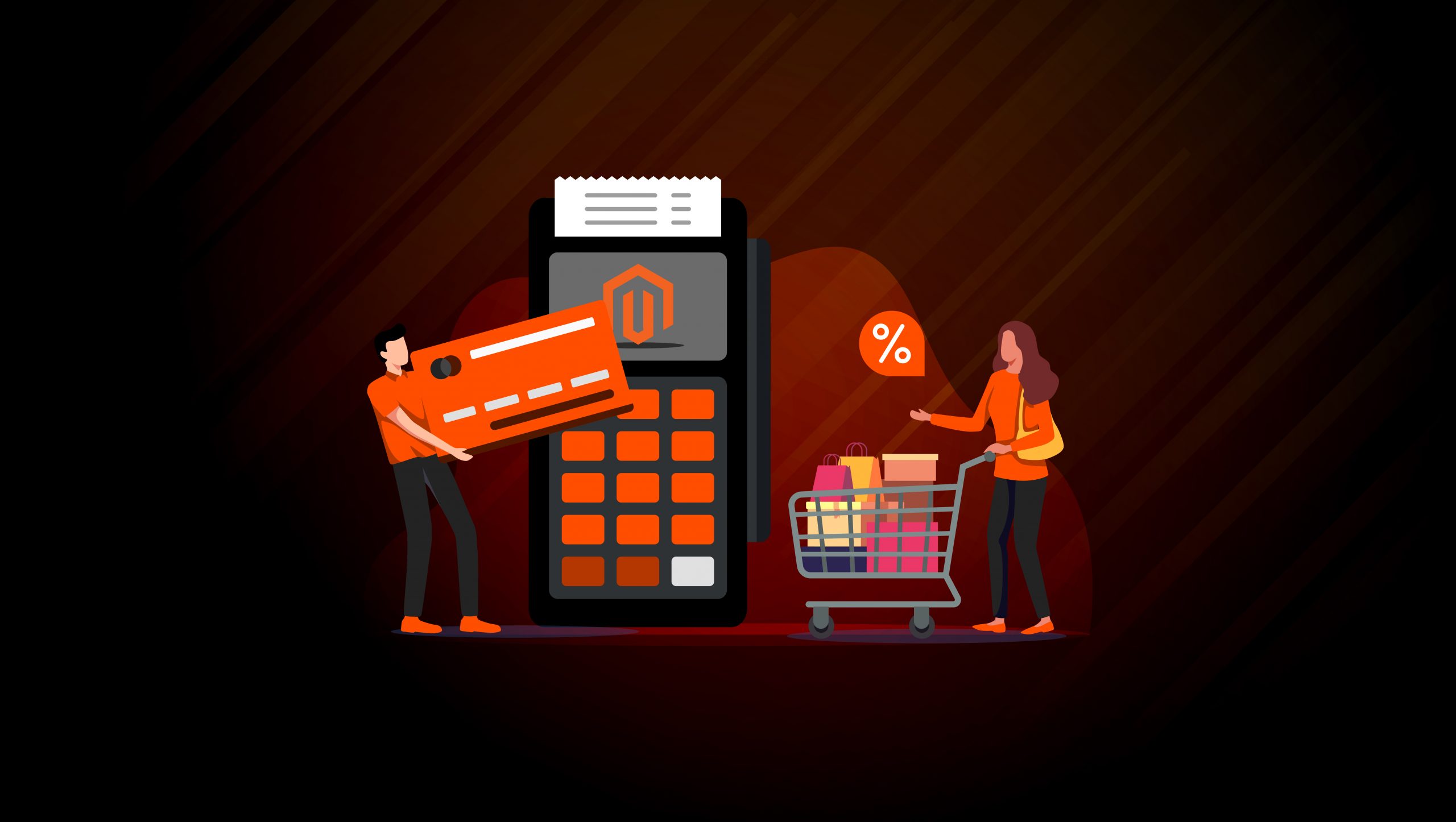In an effort to keep pace with the ever-changing demands of modern consumers, businesses around the globe are actively seeking innovative strategies. Speed is a non-negotiable factor in today’s consumer landscape, as individuals crave instant access to everything they need or desire.
Quick Commerce, or q-commerce, has emerged as a game-changing solution to address this demand. While it was initially adopted by the food, groceries, and pharmaceutical sectors, q-commerce has revolutionized the landscape of the fashion and retail industry as well. It’s clear that q-commerce is no longer just an option for businesses; it has become an essential strategy to stay competitive and meet the evolving preferences of today’s consumers.
What is the Impact of Quick Commerce?
On a global scale the quick commerce marketshare is experiencing rapid growth, projected to achieve a Compound Annual Growth Rate (CAGR) of 15.20% from 2022 to 2027. As of 2022, the global q-Commerce market is valued at $91.22 billion USD. This value is anticipated to reach $185.10 billion USD by 2027, maintaining the same CAGR of 15.20%.

Furthermore, the customer base is expected to grow significantly, reaching 789.1 million users by the end of this period. These statistics foretell the substantial growth and rising demand of Q-commerce on the international stage.
This brings us to the next big question..
Is Q-commerce Right for you?
While the statistical projections indicate the robust growth of the Q-commerce industry and its many benefits, it’s important to approach this trend with thoughtful consideration before jumping on the Q-commerce bandwagon. Several factors should be taken into account to ensure a strategic and successful integration into this dynamic market.
Let’s take a look-
Customer Demand
It is essential that you review your customer base before transitioning to quick commerce services. Examine your current customers and potential target audience to understand their interest in ultra-fast delivery. Consider their lifestyle choices, ordering behaviors, and willingness to pay extra for swift service. Understanding these aspects provides valuable insights into the market demand for quick delivery within your customer base, helping tailor your approach to meet their expectations effectively.
Assessing Product Compatibility
Evaluating your product range is indispensable while launching a q-commerce model. Examine the suitability of your product range for swift delivery. Perishable products often have a greater demand, during peak-times, or are commonly impulse buys that are aligned with the principles of quick commerce services. Recognizing these characteristics within the scope of your business allows you to identify which items are most conducive to create a rapid delivery model, enhancing the overall effectiveness of your q-commerce strategy.
Analyze Market Based On Location
Analyze your intended market and assess the viability of strategically locating dark stores (micro-warehouses) in optimal delivery zones. Take into account variables such as population density, traffic patterns, and the availability of a well-established delivery infrastructure. This examination aids in determining the practicality of your q-commerce strategy within specific geographical areas, optimizing accessibility for your customers.
Assessing Your Delivery Logistics
Evaluate your organizational proficiency in overseeing the complex logistics integral to q-commerce. This evaluation should encompass areas such as fleet management, the optimization of last-mile delivery, and the adequate training provided to your delivery personnel. By thoroughly assessing these components, you can determine your readiness to adopt the complex logistics involved in the q-commerce landscape.
Evaluate Your Technological Infrastructure
Ensure that your technological infrastructure is capable of accommodating a substantial volume of orders, facilitating real-time order tracking, and enabling efficient inventory management, all essential components for the successful execution of q-commerce operations.
It is important to note that selecting quick commerce companies with advanced technology integration is quintessential, as it significantly caters to a streamlined Q-Commerce experience.
On that note, what must you look for in a quick commerce provider?
8 Key Factors in Selecting a Quick Commerce Provider

1. Technology and Platform
While choosing a quick commerce provider for your business, it is crucial to ensure that their technological offering is not only robust and reliable but also scalable to accommodate the evolving needs of your business.
A technologically advanced platform should offer features like real-time order processing that ensure quick and efficient transactions. This includes a reliable order management system, efficient delivery routing software, and a network of dark stores or micro-fulfillment centers located close to customers. Seamless integration with existing systems, such as point-of-sale and inventory management, is also essential for a streamlined operation.
In conclusion, a q-commerce provider must provide a strong technological foundation with these features to enhance the precision and responsiveness of your q-commerce operations, contributing to a superior customer experience.
2. User Interface and Experience
When selecting a q-commerce provider, it is crucial to prioritize a platform that caters to the needs of both customers and administrators. The interface should be intuitive and user-friendly, facilitating seamless order placement for customers and easy system management for administrators. A well-designed user interface not only improves overall usability but also minimizes the learning curve, ensuring a positive and efficient experience.
Mobile responsiveness is another key consideration. Platforms should effortlessly adapt to various screen sizes, making them accessible and convenient for users on smartphones and tablets. This adaptability is now considered standard practice, optimizing the overall user experience.
Therefore, it is essential to opt for a reputable q-commerce provider capable of delivering an optimal user interface tailored to the specific needs of your business.
3. Logistics and Delivery
When selecting a q-commerce provider, it’s crucial to prioritize delivery speed, efficiency, and reliability. Look for swift delivery times, efficient order processing, and high on-time delivery rates. Efficient order processing systems and last-mile optimization are key factors.
Reliability is paramount, so choose providers with high on-time delivery rates, accurate order processing, and real-time order tracking. Consider coverage by evaluating the delivery zone, density, and flexibility of the provider. Ensure they have robust technology platforms, real-time data insights, and seamless integration capabilities.
Sustainability, customer service, and experience in q-commerce logistics are additional considerations. By carefully evaluating these factors, you can find a q-commerce provider aligned with your logistics and delivery needs.
4. Geographic Coverage
When evaluating a quick commerce provider based on geographical coverage, several essential factors should be considered. Firstly, it’s crucial to ensure that the provider’s delivery zone aligns with the locations of your target customers. It’s also important to check whether the q-commerce provider offers comprehensive coverage, including both urban and rural areas, particularly if your target audience is dispersed across diverse locations. A well-planned and expansive delivery zone is key to reaching a broader audience effectively.
Another critical consideration is the service density within the delivery zone. Besides, it is crucial to consider the scalability of the provider’s operations, ensuring they can accommodate your business growth and expand geographical coverage accordingly.
For businesses with international operations, it’s essential to verify whether the provider can facilitate cross-border deliveries and maintain a reliable network in the regions you serve. Confirm that the provider’s technology infrastructure, including routing algorithms and tracking systems, is optimized for efficient operations throughout the specified geographical coverage.
5. Product Range and Quality
When choosing a q-commerce provider, a critical factor to consider is the diversity and comprehensiveness of their product range. Ensure they cover a wide range of categories relevant to your target audience, spanning groceries, fresh produce, prepared meals, household essentials, electronics, pharmaceuticals, and more.
It is important that the provider’s product range align with your target consumer demographics. Ensure the selection reflects local preferences and demand within your operating area, adapting to seasonal trends and special occasions. Prioritize product quality, specially for perishable items and evaluate the provider’s commitment to quality control throughout the supply chain and their delivery logistics, particularly for maintaining optimal conditions during transportation. Additionally, review customer feedback and online reviews to gain insights into the reputation of the brands featured in the provider’s product range.
6. Quality Assurance Measures
Prioritize order accuracy by choosing providers with automated order verification systems and robust picking and packing processes. Opt for quick commerce services that conduct multi-stage quality checks to minimize errors.
Evaluate the provider’s delivery timeliness, considering on-time delivery rates, real-time order tracking, and the reliability of their delivery partner network. For product quality and handling, confirm the availability of temperature-controlled storage, damage prevention measures, and a clear returns and replacements policy.
Assess the technology and infrastructure, opting for providers with automated systems and robust inventory management. Ensure data security compliance and prioritize customer service with 24/7 support, efficient complaint resolution mechanisms, and active customer feedback collection for continuous improvement.
7. Transparent Pricing Policy
Pricing is one of the biggest deal breakers while choosing the right quick commerce companies for your business. Firstly, opt for a provider with a clear and straightforward fee structure, ensuring that costs associated with services, delivery, and any additional features are explicitly communicated.
Flexibility in pricing models is another critical factor to consider. Look for providers offering plans that can be adjusted to align with your evolving business needs. Additionally, if your business involves significant order volumes, explore providers that offer bulk discounts or volume pricing to optimize costs as your operations scale.
You must also consider dynamic pricing models that may adjust based on factors like demand or delivery location, understanding their impact on your budget. Explore subscription plans for cost predictability, especially beneficial for businesses with consistent order patterns. Review contract terms, including cancellation policies and renewal processes, for clear navigation.
8. Hidden Fees To Watch Out For
When choosing a quick commerce provider, be cautious about hidden fees. In delivery, watch out for dynamic pricing, minimum order value restrictions, and surge pricing during peak hours. Service fees may include extra charges for pick-and-pack, order cancellations, and returns processing. Consider platform and technology fees like subscriptions, software licenses, and API access. Watch out for hidden costs in payment processing, inventory management, and marketing services when choosing a q-commerce provider. To avoid these, scrutinize service agreements, inquire about unclear fees, negotiate pricing structures, compare offerings from different providers, and consistently monitor expenses for any unexpected charges.






